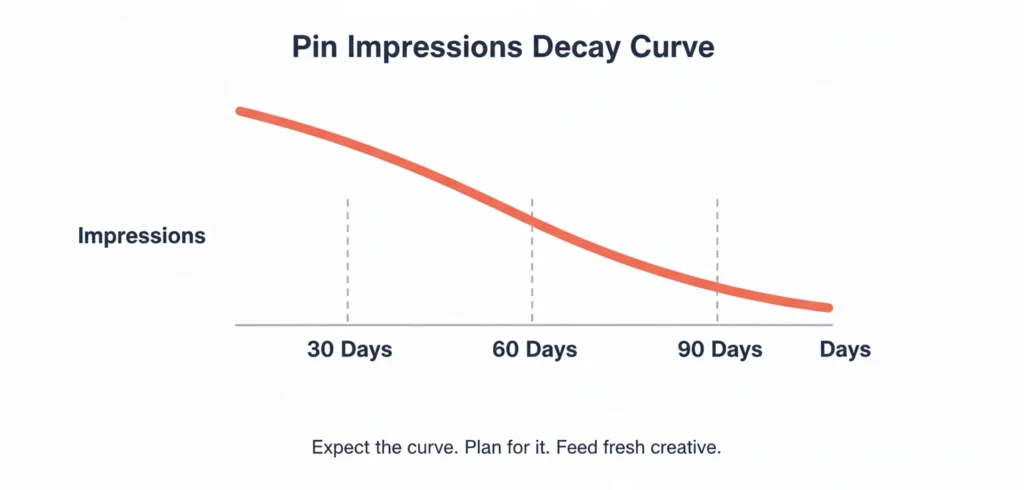
I’ve been there: you’re posting every day, the calendar looks full, and then—wham—impressions fall off a cliff.
No warning. No big change on your end. Just… less.
Here’s what’s really going on, and how to turn the graph back up.
Why did my Pinterest impressions drop even though I’m posting?
Pinterest doesn’t reward volume alone anymore. In 2025 its ranking system (often described as TransActV2) weighs far more contextual clues, and—as MadPinMedia notes—considers 16,000+ signals. If freshness (new images + new text), timing, or account health slip—even a little—impressions can sink even when you’re still posting.
What changed in the algorithm in 2025?
Pinterest’s ranking based on 16,000+ signals shifts the emphasis from “Did you post today?” to “Is this Pin fresh, relevant, and coming from a healthy account history?” Old habits—like batching near-identical designs or posting at random hours—don’t carry you the way they used to.
Why posting frequency isn’t enough
Consistency helps, but it’s not a safety net. In our data we see accounts post daily and still slide when the mix is heavy on look-alikes, packed too tightly together, or pushed at off hours. The top 1% of Pins drive more than 50% of impressions and clicks, so every slot has to pull its weight.
Why consistency alone doesn’t guarantee growth
Even daily posting can underperform if hidden tripwires are in the calendar.
Duplicate Pins vs. fresh Pins
Pinterest treats a fresh Pin as a unique image and text combo for a given URL. Re-using the same image or barely changing a line of copy? That’s a duplicate. Duplicates dampen reach over time. Tailwind’s Pin Spacing enforces a minimum gap between Pins to the same URL (simple baseline: 7 days). That protects account health when you’re working in batches.
Timing mistakes that hurt visibility
If you cluster a bunch of Pins at noon because that’s when you had time, you’ll often give them a weaker start. Many audiences peak in the evenings (8–11 PM local time) so your plan should reflect that rhythm. Tailwind SmartSchedule fills your calendar with time slots chosen from Tailwind’s Pinterest scheduling dataset so you don’t have to guess.
Algorithm & seasonal shifts
Two realities can lower impressions without any mistake on your end: platform-wide updates and seasonality. When Pinterest shifts the goalposts, fresh Pins and safer spacing act like shock absorbers. Seasonal dips (post-holiday, midsummer) happen; keep your queue steady and your assets fresh.
How fresh Pins influence impressions
Fresh Pins are the engine of modern Pinterest reach. New image + new text = a new shot at distribution. Repins or near-duplicates won’t carry growth the way they once did, so you need a reliable stream of new creative—without burning out.
What counts as “fresh”?
- New image (layout, crop, or background)
- New text (on-image and in the description)
- Same URL is fine—the visual and wording must be new
Tailwind SmartPin can generate a new Pin for an enabled URL on a weekly cadence with unique image + copy, and drop it into your scheduling flow.
Why freshness beats repins
Unique Pins continue to earn distribution while repins taper fast. If your calendar leans on repeats, you’ll see impressions flatten, then slide. Fresh creative—small variations over time—keeps the engine turning.
Automating freshness with SmartPin
Enable SmartPin on a URL once. Each week it proposes a new design and fresh title/description based on your page context and keywords. Swap templates, tweak fonts/colors, or use the original image when overlays don’t fit (think diagrams or product shots). Then schedule like any other draft.
Can scheduling tools really improve engagement?
Short answer: yes. Three pieces work together:
- Pin Spacing prevents spam-like patterns with a minimum interval per URL.
- SmartSchedule places Pins at stronger times across the week; you can regenerate the plan or lock a Pin to an exact time.
- Pin Scheduler lets you batch without losing safety or timing.

Pin Spacing for safe posting
When you upload a lot at once, spacing rules make sure two Pins to the same URL don’t go out too close together. The rule guarantees a minimum interval; it balances across your calendar rather than enforcing a perfect, fixed gap. That guardrail removes a common self-inflicted slowdown.
SmartSchedule for stronger timing
SmartSchedule builds a calendar of time slots so you’re consistently publishing at hours that tend to perform better. You can regenerate, add/remove slots, and lock mission-critical Pins. The result: fewer dry hours, more stable reach.
Pin Scheduler as your workflow hub
Draft, batch, and queue Pins in one place. Shuffle to fill gaps. Use Ghostwriter to write unique titles and descriptions when you’re short on time. It’s the control room that ties SmartPin, Pin Spacing, and SmartSchedule together.
What Tailwind data reveals about impressions decay
Even healthy Pins slow down with age. Tailwind research shows that many see natural decay over 30–90 days. A few keep compounding for months, but banking on outliers is a risky plan. Expect the curve, plan for it, and keep feeding fresh creative.

30/60/90-day benchmarks
As Pins age, impressions and saves taper in predictable steps. Plan your calendar expecting that curve, and keep feeding it new creative so today’s Pins replace yesterday’s momentum.
Case study: restoring reach
We’ve seen brands rebound by shifting two habits: reducing near-duplicates and trusting SmartSchedule’s evening slots. Add weekly SmartPins, and impressions often recover to (and then exceed) pre-drop levels over the following weeks.
How to fix Pinterest impressions drops today
Give yourself 30 minutes. Do this now.
- Turn on SmartPin for your top URLs
Pick 3–5 evergreen pages. Enable SmartPin. You’ll get one fresh Pin per URL each week without extra work. - Set Pin Spacing rules
Use the default 7-day minimum to avoid back-to-back Pins from the same URL. Add custom rules for heavy-traffic pages. - Regenerate SmartSchedule
Let it refill your calendar with evening/after-work time slots and lock any must-hit Pins as needed. - Batch in Pin Scheduler with Ghostwriter
Load next week’s drafts, generate unique titles/descriptions, and ship them into your queue. - Watch the right signals
Freshness rate, spacing health, and evening coverage. Expect a normal fade on older Pins. Keep the queue moving.
Conclusion: Can you recover from a reach decline?
Yes. Drops are common in the new system, and they’re reversible. Ship more fresh Pins, keep a safe distance between similar posts, and publish at stronger hours. Run that play for a few weeks and the curve usually bends back up—then keep going. 
Key takeaways
- Freshness drives reach.
- Spacing prevents self-inflicted slowdowns.
- Timing compounds results.
- Natural decay is normal—plan for it.
- Tailwind automates the repetitive parts so you can keep moving.
Try it: Set up SmartPin, Pin Spacing, and SmartSchedule inside Pin Scheduler and give your next 30 days a cleaner runway.

The post Why Did My Pinterest Impressions Drop Even Though I’m Posting? appeared first on Tailwind Blog.














